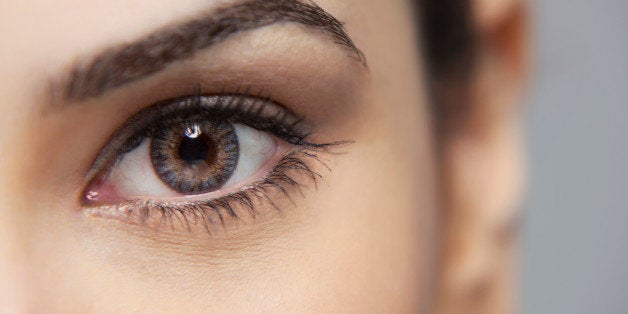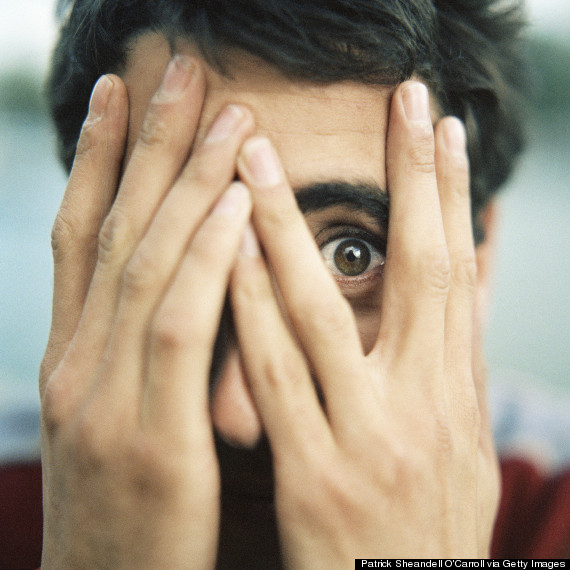
Eyes may be the windows to the soul, but how much do you really know about them? We're aware that they're pretty irreplaceable (there's no such thing as an entire eyeball transplant, after all), but what are they made out of? And what does the shape of an eyeball have to do with vision? We talked to Dr. Rebecca Taylor, M.D., an ophthalmologist in private practice in Nashville, Tenn., and a spokesperson for the American Academy of Ophthalmology, to find the answers to the eye questions that have always lurked in the back of your head (which also happens to be where your occipital lobe is).
The best that a human eye has been recorded to see is around 20/10.
That means that a person can see at 20 feet what the rest of us need to stand at 10 feet to see.
Meanwhile, a hawk can school us all.
What a hawk can see at 20 feet, we would have to be at three feet to see.
The term for having two different-colored irises is called heterochromia iridis.
Heterochromia iridis is hereditary, meaning it runs in the family. However, if you grew up having the same colored eyes but then noticed later in life that one eye has changed color, that could actually be a sign of sickness and you should get your eyes checked out by a doctor. (In addition, babies born with different-colored eyes but who don't come from families where heterochromia iridis is known to exist, should also be checked out by a doctor in case the difference in eye color is a sign of sickness.)
There's a word for fear of eyes.
...And it's called ommatophobia.
As painful as it is to get poked in the eyeball, our eyes actually heal quite quickly.
Some abrasions can heal within 24 to 48 hours. However, that incredible, unbearable pain when your eye is scratched has an important function -- if a scratch in your eye gets infected, it could potentially lead to blindness. So if you experience any sort of injury to your eye, you should see your doctor in case you need antibiotics to stop infection.
It's possible for your eyes to get sunburned.
That's why it's so important to wear sunglasses that protect against UVA and UVB rays. Sunburn to the eye isn't the same as sunburn to the skin, where the effects are relatively immediate with pain, redness and peeling. When sunburn occurs to the eye, it's over a long, gradual period of time; the prolonged sun exposure will eventually lead to thickened tissue within the eye, which might necessitate eye surgery.
Yes, it's possible for your eyesight to get "better" with age.
But that's not necessarily a good thing, because it could be a sign that something larger is amiss with regard to your health. For instance, if you started out as having a +3 prescription (where 0 is normal vision, +1, 2, 3, etc. means farsightedness and -1, 2, 3, etc. means nearsightedness), but then were to develop a condition that would affect vision, such as diabetes, and make you more nearsighted, that could end up correcting your vision to the point where you went from being a +3 to a 0. The bottom line: If you are noticing a big change in your vision, you should see a doctor to find out what's going on.
Your eyeball is slightly smaller than a gumball.
A gumball you'd get from a grocery store gumball machine gumball is about 27 to 28 millimeters wide. The average human eyeball is 24 millimeters wide.
The lens in your eye is about as big as an M&M candy.
The lens, which focuses for the eye like a lens would focus for a camera, sits right behind the pupil. It's almost exactly the same size as a plain M&M candy. The lens in your eye even has protein encased in a capsule, just like an M&M.
And developing a cataract in your eye is kind of like developing a peanut in that "M&M."
Think of it as the "chocolate" in the M&M getting harder and developing a little peanut.
Having 20/20 vision isn't the same thing as having "perfect" vision.
To have 20/20 vision means to have "average" vision. It means that you can see at 20 feet what an average person can see at 20 feet.
The "visual centers" in your brain are actually located at the lower back part of your head.
That's why if you were to fall very hard on the back of your head, it's possible to go blind temporarily. The optic nerve begins at the back of the eye and, through a series of connections, relays the visual images to the occipital cortex in the very back of the brain.
The length of your eye helps determine what kind of eyesight you have.
In addition to the eyes' lens and corneal function, the length of your eyeball has a lot to do with whether you're nearsighted or farsighted. People who are nearsighted have a longer-than-normal eyeball, while people who are farsighted have a shorter-than-normal eyeball. Just a millimeter change in the length of the eye will change the prescription for that eye.
Your eyeballs get bigger as you grow up.
When you're born, your eyeballs are each 16 millimeters wide. But by the time you turn three, they will grow to each be 23 millimeters wide. Your eyeballs will reach their maximum size when you hit puberty -- around 24 millimeters wide.
Think of an eye as a house with two rooms.
There's the foyer and the back room. The foyer, a.k.a. the anterior chamber, is where your cornea is (where you put your contacts) and a fluid called aqueous humor that contains nutrients that are good for the eyes and bathes the iris of the eye. Behind the iris sits the lens of the eye. Behind the lens of the eye is the "back room," a.k.a. the vitreous chamber. In this chamber is jelly called vitreous humor, which has the consistency of egg whites (but is really made out of water and hyaluronic acid).
But an eye is also kind of like a baseball.
As much as you can think of the eye as having two "rooms," you can also think of your eye as having layers -- similar to what you'd see if you were to take a baseball and cut it in half. The eyeball has an innermost layer, a middle layer, and an outermost layer. The outer layer of the eyeball is called the sclera, which is like the white covering of a baseball, and is also the part that you can visibly see. Underneath that is a layer with lots of blood vessels, called the choroid. The innermost layer is the retina of the eye.
Some people have lighter eyes and other people have darker eyes thanks to cells called melanocytes.
Melanocytes, the cells that produce color in our skin, are also responsible for producing coloration of our irises. Some people have more melanocytes, which means their eyes are darker -- and the number of melanocytes a person has is coded in his or her genetics.
Everyone is born with eyes that are at least slightly lighter than they are now.
We aren't born with any special pigmentation -- like freckles or moles -- and that same concept applies to eyes, too. That means pigmentation of our irises isn't fully developed at birth; pigmentation occurs in the first year of life, which means our eyes are darker now than they were when we were newborns.
Staring directly into the sun will make you go blind.
Remember when you were a kid and you used the sun's rays to burn a piece of paper using a magnifying glass? That same exact thing can happen to your eyes if you stare into the sun. That's because the lens in our eye focuses the sun's rays on to the retina, burning a spot in the retina that causes permanent vision loss. (The medical term for this: solar retinopathy.) In other words: Just don't do it.
Not all eye floaters are alike.
One person's eye floater is not always the same as another person's eye floater. For people over age 55, eye floaters are often caused by posterior vitreous detachments, which is when the retina and the vitreous membrane separate. But eye floaters can also be pigment, or blood, or inflammation. If you have an eye floater, go see your eye doctor to get it checked out.
For more information about eye diseases and conditions, check out the American Academy of Ophthalmology's website.